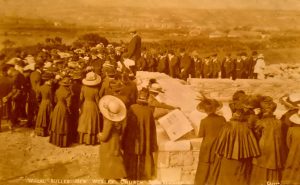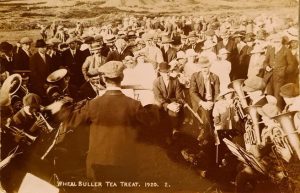
Wheal Buller is to the south of Redruth on the Helston Road. This profile of Wheal Buller Wesleyan Chapel has been compiled by Jo Lewis and Tony Mansell with considerable input by David Thomas.
“I’m going to look at the history of its two successive Wesleyan chapels and especially the early history of the Society.
In the Circuit archives at Kresen Kernow there are some unsigned notes, compiled around 1968, which shed a lot of light on the matter.
The first Wesleyan chapel at Wheal Buller was constructed in around 1833 and was sited to the east of what became the later chapel and down what is now a lane, but which in the nineteenth century was an active railway branch line serving the Wheal Buller mine. Our first picture is a postcard view by an unknown local Edwardian photographer of around 1905, showing the original chapel and is indeed one of the rarest Cornish Methodist chapel pictures from my collection amassed over the last half century. The building appears to have been recently whitewashed but the roof doesn’t look to be in too great a condition. The entrance door appears to be contained within a small porch but the really striking thing is that worshippers exiting the building would step out of the Chapel gateway right onto a railway line. This must be a situation unique in Cornwall and indeed. probably in the UK.
The chapel is mentioned on a Redruth Wesleyan Circuit plan of 1836 and when the first (and only) religious census was taken on 30 March 1851, which was a fine day, the chapel only held an afternoon service attended by 60 adults and 5 children. This seems a reasonable attendance for such a small and scattered community, drawing its attendees from the local Wheal Buller mining population.
In 1876 the chapel is given as having 80 seats and had a membership of 22. In 1888 the building was registered for worship. It has been estimated that in the 1870s the chapel was attracting about 55 people to regular Sunday worship.
In the early 1900s the Society made moves to build a second chapel on a site adjacent to the very steep Buller Hill which led out of the town of Redruth towards the local settlement of Four Lanes and onwards to the Market Town of Helston. It is not clear whether the original chapel had become too small or whether a better or more substantial place of worship was desired by the Society. A site, as abovementioned, was obtained and three days after the cataclysmic sinking of the RMS Titanic the foundation memorial stones of the new building were laid on 18 April 1912. This is the event depicted below, a postcard view taken by local Redruth photographer W J Caddy, one of a commemorative series taken on that occasion. Crowds gather in their best Edwardian dress to witness the event, with not a lot of social distancing it has to be said! It is interesting how the women and men appear to congregate in separate groups while one of the stone layers appears to be making a speech. Caddy has captured the event well.
The Trust of the second chapel, registered for worship in 1912, was renewed on 15 June 1923, 16 August 1939 and finally on 23 October 1974. Trust minutes survive from 1911 while the Circuit Archives also contain the accounts of a Wheal Buller Sunday School Burial Club from 1895 to 1933. This assisted with the cost of club members’ funeral costs, if the need arose and these clubs were a feature of some Cornish chapels.
Wheal Buller mine, the economic raison d’etre of this part of Redruth parish was at work until the 1930s but after its final closure the decline of this chapel set in. In 1939 there were 11 members, 5 by 1956 but by 1967 this had declined to only 2. (Membership figures are however different from actual chapel attendances it should be noted). According to the 1968 archival notes Mr A F Thomas of Treruffe attempted to revive the Society during the ministry of the Revd EJ Mitchell and remained faithful to this cause until his death. In 1950 he noted an attendance of 12 which included 6 children. There was a mid-1950s highwater mark attendance in 1954 with 17 attending, including 6 children but this declined to 5 by 1964. He notes that one service was cancelled because of frost in 1965 and on one Sunday in 1967 he recorded a congregation of 3.
In 1972 there was an application to the Circuit to wind up the Society and close the chapel, which received all the necessary approvals but for some reason this decision was later rescinded and the chapel valiantly carried on for nearly a further 20-year period. The Redruth archives contain a file on the closure and sale of the premises in the period 1989-1991.
In the period 1876 to 1968 the Wheal Buller Methodist Society lost 91 per cent of its membership in a 92-year period, a decline rate of about one per cent per annum. To set this all in a wider context locally it is noted that in 1850 the Redruth Wesleyan Circuit had 2084 members, in 1851 this was recorded as 1901 and rose to 2111 in 1864 during the last great nineteenth century boom decade of Cornish mining. That mining economy collapsed from the 1870s onwards and by 1968 the Redruth Methodist Circuit was down to 1084 members, losing roughly half its membership in 100 years or thereabouts.
The Wheal Buller Wesleyan Society is therefore an interesting microcosm case study, and indeed much more research could be undertaken. It embodies a nineteenth century chapel in the heart of the principal mining area of Cornwall, whose fortunes and survival marched along and were inextricably bound up with that industry. It also exhibited a degree of self confidence in the pre-First World War era, with the construction of a newer and more commodious structure, flying in the face of that mining decline but having to contend also for some 80 years worshipping on a site halfway up (or halfway down as the case may be) a steep hill. It really was a testimony in stone to the faith of all of the people concerned and therefore deserves to be recorded and remembered, truly a ‘City set on a hill’ and yes, a Cornish mining hill which supported many families for generations, both in work and by prayer.” (David Thomas 7 May 2021)
1833 Wesleyan Chapel
 The 1833 chapel taken in 1905 (Photo: courtesy David Thomas)
The 1833 chapel taken in 1905 (Photo: courtesy David Thomas)
1833: Build date. (SWChurches)
Built as a Wesleyan Chapel adjacent to Wheal Buller mine. (SWChurches)
Seating for 75.
Robert Bond minister.
Four Lanes Band was on hand for the 1872 Wheal Buller Wesleyan School annual tea. The procession made its way through Carnkie and Four-lanes and then to a field near the chapel. (Royal Cornwall Gazette 10th August 1872)
1880: Shown on map. (old maps.co.uk)
1888: Certificate of registration, Wheal Buller Wesleyan Chapel, Redruth. (Kresen Kernow MRR/1413)
1908: No longer shown on map as a chapel. (old maps.co.uk)
Seen on 1880 maps, by 1908 it is no longer marked as a chapel. It was presumably replaced but the 1912 chapel. A building remained for a while but is now lost.
1912 Wesleyan Chapel
Methodist chapel, now converted to house. Rubble with granite dressings and part rendered; steep dry slate roof. Gothic style with pointed arches. 3-bay front end has coped gabled centre bay broken forward and with ventilator over stepped 3-light mullioned widow. Single lancets to other bays and to side elevations. Right-hand return has gabled porch with doorway to front side. Dressed granite forecourt walls with rounded corner by adjacent lane; granite gate-piers. Sited next to mineral tramway. (Cornwall Heritage Gateway)
 The 1912 Chapel which later became a residence (Photo: Jo Lewis)
The 1912 Chapel which later became a residence (Photo: Jo Lewis)
 The memorial stones of the new building were laid on 18 April 1912. (Photo: courtesy David Thomas)
The memorial stones of the new building were laid on 18 April 1912. (Photo: courtesy David Thomas)
NEW WESLEYAN CHURCH AT WHEAL BULLER. Foundation stones a new Wesley church at Wheal Buller, near Redruth, were laid on Thursday in the presence of a large assembly, presided over by the superintendent Wesleyan minister (the Rev. Stuchbery). The church will be of Gothic design, and will measure 31 feet by 21 feet, and accommodate 100 persons. Provision has been made for future extension, if necessary. The building and furnishing will cost about £550, and towards this sum about £350 has been promised. Mr. Sampson Hill the architect, and Mr. John Odgers the contractor…” (West Briton and Cornwall Advertiser – Monday 22 April 1912)
1912: Build date. (Cornwall Heritage Gateway / SWChurches)
Part of Redruth Wesleyan Circuit. (SWChurches)
1912: Papers, construction of new chapel, Wheal Buller Wesleyan Chapel, Redruth. (Kresen Kernow MRR/1416)
1912: Certificate of registration, Wheal Buller Wesleyan Chapel, Redruth. *Kresen Kernow MRR/1414)
 A very unusual view of the Wheal Buller Wesleyan chapel treat taken in the summer of 1920, by the Redruth photographer W J Caddy. What makes this picture special is that Caddy has placed his camera at an elevated level to look over the head of the band’s conductor and has captured a view of the band playing but also the attendees and spectators listening to the programme of music which always featured on such occasions. (David Thomas)
A very unusual view of the Wheal Buller Wesleyan chapel treat taken in the summer of 1920, by the Redruth photographer W J Caddy. What makes this picture special is that Caddy has placed his camera at an elevated level to look over the head of the band’s conductor and has captured a view of the band playing but also the attendees and spectators listening to the programme of music which always featured on such occasions. (David Thomas)
1932: The Wesleyan, Primitive Methodist and the United Methodist Church amalgamated to become the Methodist Church of Great Britain.
1932: Became Wheal Buller Methodist Church. (SWChurches)
Part of Redruth Methodist Circuit. (SWChurches)
1940: Seating for 90. (David Easton, Methodist Minister and historian)
1833-1968: Historical notes, Wheal Buller Methodist Church, Redruth. Unattributed, compiled c1968. (Kresen Kernow MRR/1992)
1969: A move to close the chapel was rescinded. (David Easton, Methodist Minister and historian)
1989: Closed. (SWChurches)
1989: “Chapels to be auctioned. Two country chapels built last century when the mines were still at work, come under the auctioneer’s hammer at the Royal Hotel. Truro, next Friday. Martin and Buddell of Truro are selling the closed Wheal Buller Chapel. Just outside of Redruth. and Higher Carnkie Chapel, in the nearby village Both are redundant. “We have had quite a good response to both. The guideline price was £3O 000 each. The chapels are being sold by Redruth Methodist Circuit and include a covenant, which says that neither can be used for the manufacture or sale of intoxicating liquor for gambling, nor by other religious groups without the Methodist Circuit’s permission.” (West Briton and Cornwall Advertiser – Thursday 16 November 1989)
1989-1991: Correspondence, closure and sale of Wheal Buller Methodist Church, Redruth. (Kresen Kernow MRR/1991)
Sold. (SWChurches)
The chapel is now a private residence.
The Chapel Harmonium was supplied by Chandlers of Redruth and made by the Bell Organ Company of Canada. it found its way to St Agnes and was rescued in 2019 for restoration.
Old pictures of the chapel can be found in Cornish Memory: http://cornishmemory.com/items/browse?search=wheal+buller
